A Tourist to the DMZ
I’d read about visiting the DMZ a number of times before I arrived in Seoul. DMZ stands for the Demilitarized Zone between North and South Korea, which is anything but demilitarized. It’s a wide strip of no-man’s-land that embodies the tension between these two countries, still officially in a state of war. Outside of that strip, the movement of civilians is also to some extent limited.
It’s become a standard tourist destination for Westerners, though, especially Americans. Some of the sights are off-limits to individual tourists, so the usual thing is to take a bus tour, which a number of organizations offer. In 2014, Korail (Korean Railway) began offering a train version of the same thing. It uses the old rail line that used to link up to the Trans-Siberian Railway before the division of Korea.
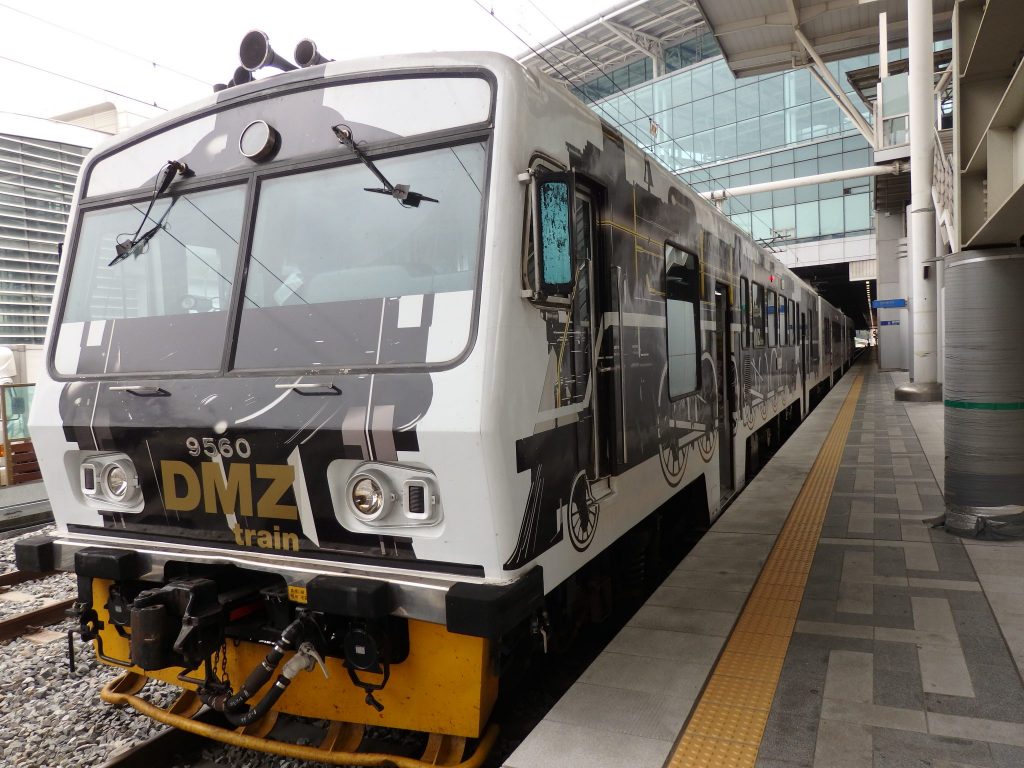
These tours are rigorously controlled. A standard itinerary on the Gyeongui Line is pretty much required and includes several propaganda stops: the Nuri Peace Park; the Dorasan train station, from which visitors can see the barbed wire of the DMZ; and several observation points overlooking the DMZ. They visit one of the famous tunnels presumably built by the North Koreans to infiltrate South Korea: the “Third Tunnel of Aggression.” The highlight is visiting Panmunjom, where a building bridges the border. There, the two sides signed the armistice in 1953 that created the DMZ. Both North Korean and South Korean soldiers stand guard.
When I talked to my blogger friend, Nancie from Budget Travelers Sandbox, about taking the tour together, we decided to take the train tour, since we liked the idea of traveling by train better than bus. However, on the day we could both go, there were no available seats.
Book your accommodations in Seoul.
On the Train
It turned out that Korail also opened up another new DMZ route in 2014: the Cheorwon National Security Tour on the Gyeongwon Line. It goes to a spot on the DMZ that’s further northeast, so we signed up for that one. Paying 25,000 won (about €25) round-trip, we boarded a prettily-painted small train: only three cars, done up with flowers and cartoon figures holding hands. The theme is peace between the North and South, a constant reminder of how far the two sides are from actual peace.
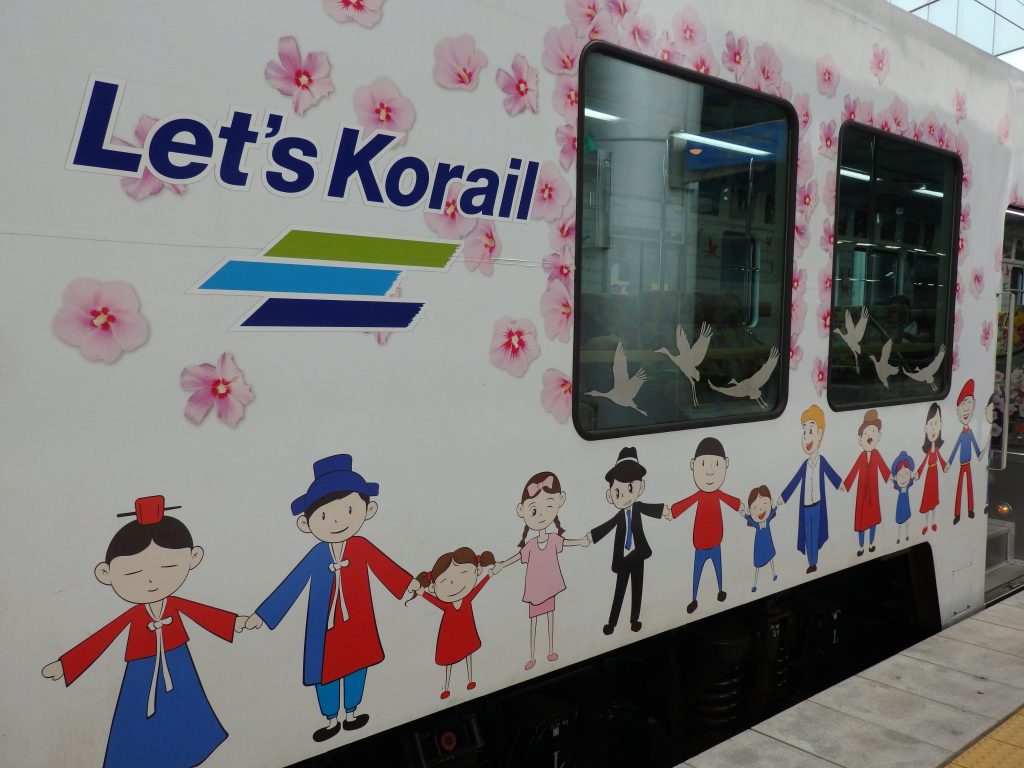
The trip up took more than two hours, since we were visiting Baengmagoji, further away from Seoul than the standard tour goes. Attendants kept the passengers entertained by pointing out things along the way and taking pictures of us to project on screens in each car. A bar served drinks and snacks and handed out free DMZ postcards. Although the voice over the loudspeakers spoke only Korean, the general air of laughter and light-heartedness that greeted many of the announcements seemed a bit out of place, given the serious nature of the DMZ and its history.

It was unfortunate that all the narration—instructions, history lessons, or whatever was going on—was exclusively in Korean. It was a new route when we took it, so, unlike the standard DMZ tours, nothing was translated for us. We were the only Westerners on the train.

But no matter! We enjoyed watching the scenery pass by. As we approached the border, we could pick out signs of South Korea’s military presence in bunkers and military vehicles.

On arrival, we paid an additional 18,000 won (€18) to take a bus tour, since the last train station, Baengmagoji, which seems to mean “An Iron Horse Wants to Run”, isn’t right at the DMZ.
On all stages of the bus tour, we were accompanied by both a tour guide who kept up a constant patter, and an armed soldier, who said nothing but went everywhere with us, keeping an eye on us. At each stop, the tour guide would say something about the soldier (to thank him, I think). The tourists would applaud, and the soldier would bow to us and then leave. Immediately another soldier would board the bus and accompany us to the next stop.
Lunch
The first stop was lunch: good Korean barbeque, served buffet style, and consumed extremely quickly. This is not the time for conversation or the bus driver will be honking for you to get moving!
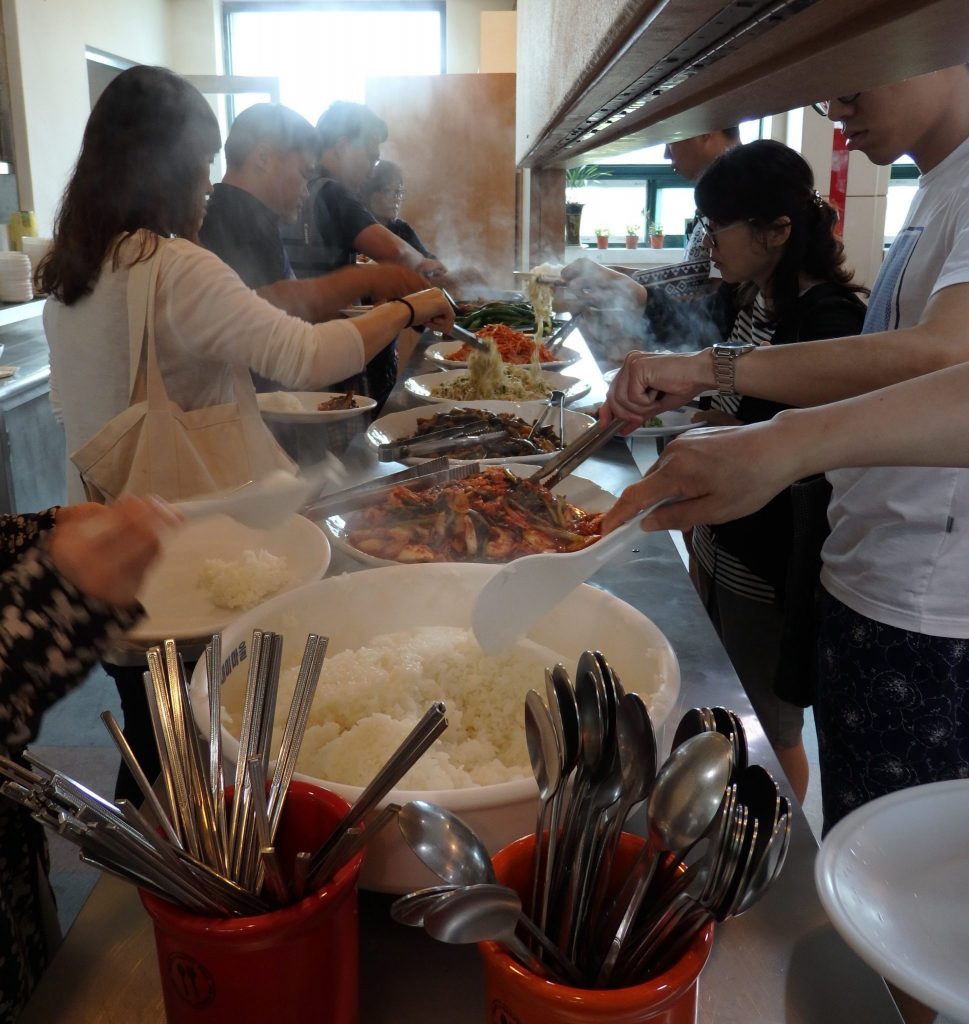
The Labor Party Building
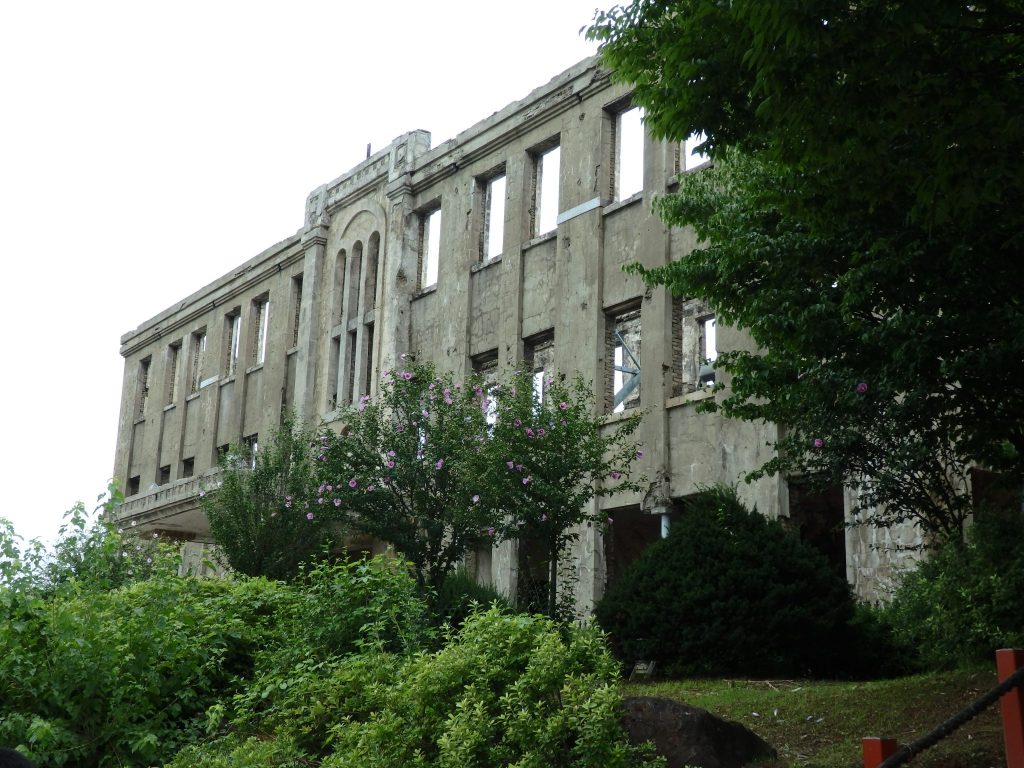
This empty shell of a building used to be the headquarters of the North Korean Labor Party. According to the one explanatory sign in English, it was also a place of imprisonment, torture and executions by the North Koreans before it ended up on the South Korean side of the truce line. The back of the building bears pockmarks from battles. The tour guide kept up a constant commentary both on the bus and leading the group around the building, all in Korean, so we wandered off as much as we dared to at least get some good pictures.
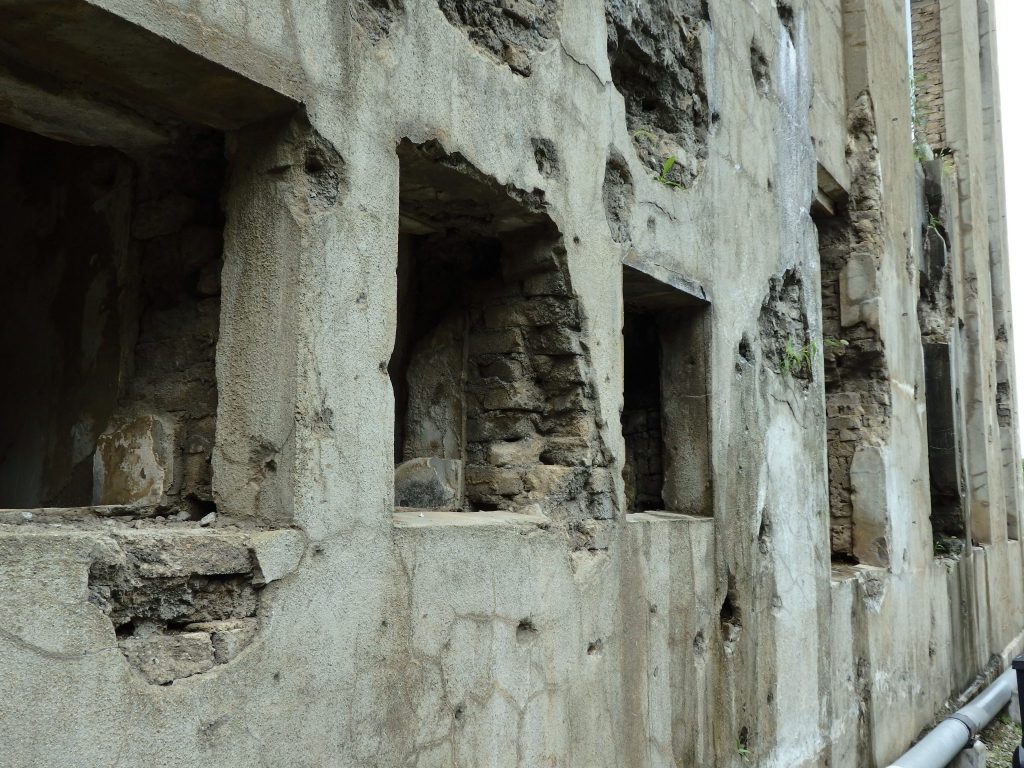
Just down the road was a military roadblock. This was not the DMZ line, but rather seemed to be placed there so that the South Korean army could keep tabs on anyone nearing the border. We snapped a few pictures, and then noticed a soldier heading at a quick pace toward us. Pretending we hadn’t seen him heading our way, we walked away toward our bus.
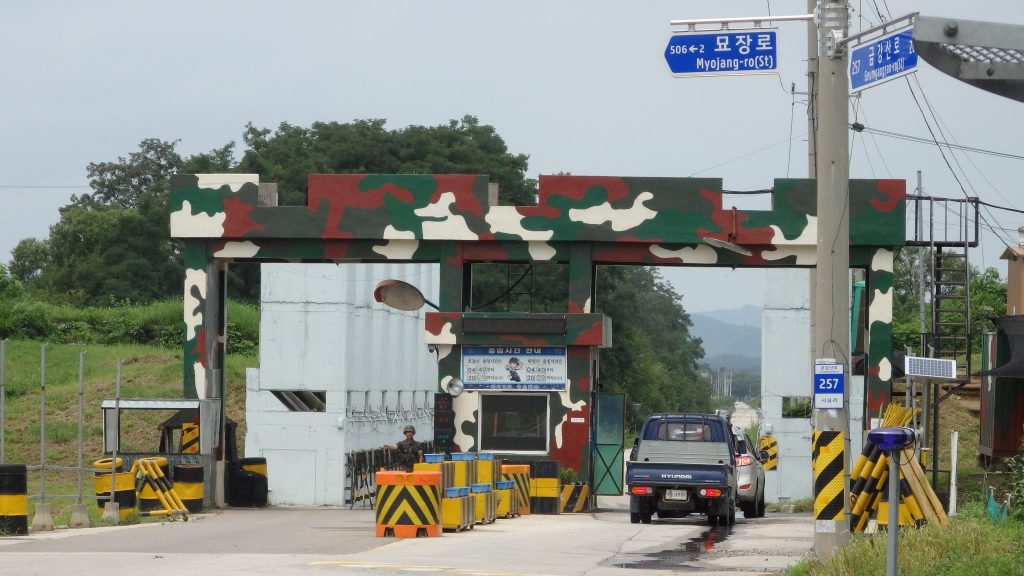
Eventually catching up with us, he shook his finger at us. “No potos.”
We looked puzzled, even though we were pretty sure he was angry that we’d taken photos.
Again, “No potos!” This time he mimed taking a picture.
“Oh,” I nodded. “Okay, no photos.” We smiled politely, thanked him, and walked away again. It didn’t occur to him, I guess, that we’d already taken them, or to order us to erase them.
Book your accommodations in Seoul.
Railway bridge
Our next stop was the Kamkang (Diamond) Electrical Railway Bridge, according to the one English-language sign. This line used to extend into North Korea. In the 1920’s and 1930’s, it transported passengers to Kamkang Mountain, a popular spot during the Japanese Occupation. It also transported mined iron sulfide to Japan, and the North Korean military used it during the Korean War.
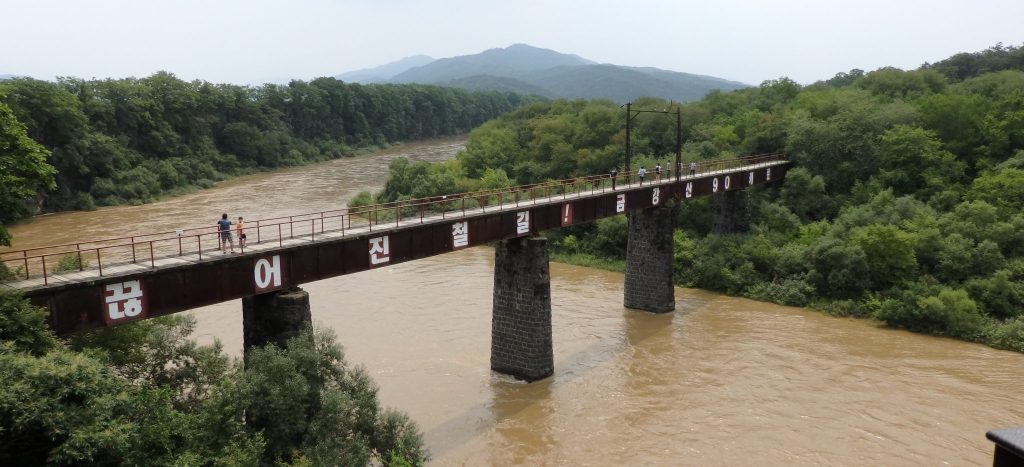
Today, it’s a bridge over a river that simply ends on the other side of the river. The railroad ties have been covered with wood boards to allow current-day visitors to walk across, though a few of the boards seemed about to give way.
Again the subject of taking photos came up. The Korean tourists (i.e. everyone but us) were taking pictures, so it seemed to be all right here. However, apparently it was only acceptable in one direction. There, the river curved, the banks seemed untouched and green: the view visible in the above photo.
In the other direction, a bridge we had just crossed with the bus spanned the river, while a smaller stone bridge, partially ruined, paralleled it. Beyond that was a big white building that looked like it was probably a barracks for soldiers. We were not allowed to photograph in that direction at all, but we already had done so by the time our soldier/guard told us to stop. This soldier also neglected to make us delete the photos.

Observation post of the Baekgol Army Division
Next we drove up a very steep road to a military watchtower. Here we could take pictures of ourselves in front of the watchtower, but not any of the views from it. Again our accompanying soldier did his best to enforce the rule.
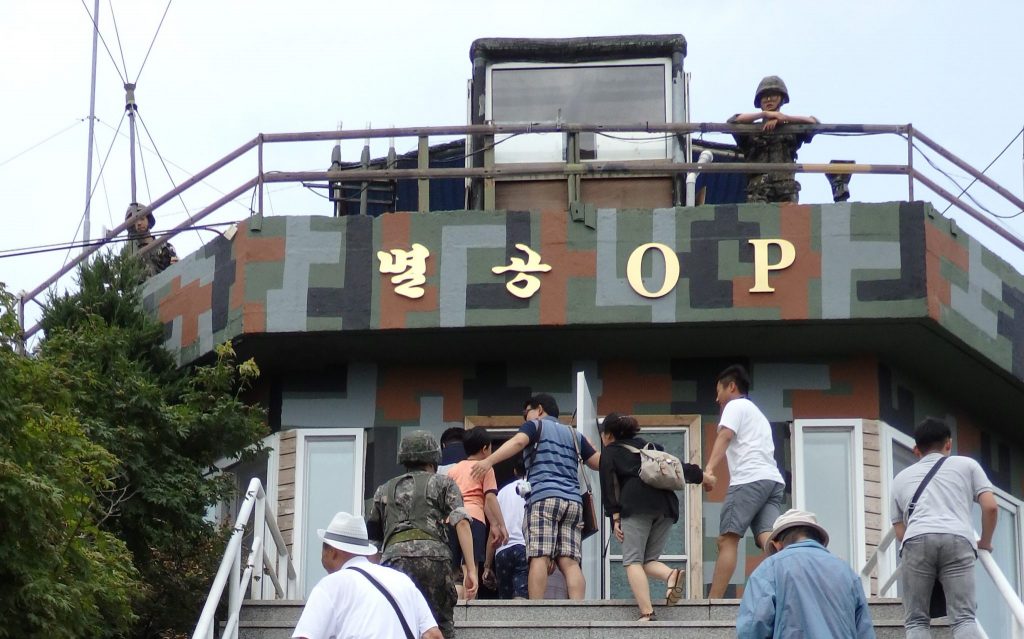
Inside the watchtower, soldiers closed all the curtains on the big windows and we settled into chairs for a movie. Entirely in Korean, it seemed to be a general history of the Korean War and the DMZ since then. The story was accompanied by heroic music and shots of soldiers shooting guns, driving tanks, and generally looking competent and brave. I wasn’t sure, but I think at least part of it was meant to be a recruitment film for young men to join the army. I think they are all required to do national service in the military, but presumably some number of enlistees are necessary for continuity as well.
Once the film was over, the curtains were opened, and we could see the view. On two distant hills perched what looked like military compounds. Far below wound a valley with a small river. On the near side of the river was an embankment and wall, with watchtowers dotted along it. We could also see a wide dirt area along the river, presumably to allow a clear view for the soldiers in those watchtowers. No pictures out the windows were allowed.
A soldier went through a long spiel using a model laid out in front of the windows. He seemed to be showing that there are three lines of defense in that part of the DMZ: the embankments and watchtowers below, the string of compounds on the mountains opposite, and another line behind the mountains. That meant that the only bits of North Korea we could see were very far away, in the rolling hills beyond.

All of this increased the sense of tension, at least for the two of us Westerners. For all of the commentary the South Koreans spout about wanting a peaceful end to the division of Korea and the tensions between the North and the South, the extremely deep-rooted distrust is loud and clear. Our feelings of discomfort, and even fear, came from the South Korean soldiers, with their guns and their banning of photographs. What are they so afraid of? Will a photo from the watchtower or one of that road block give away some sort of information to North Korea that they could use for an aggressive action? I doubt it.
Cheorwon Crane Park
It hadn’t occurred to us that the tour would be about anything but military politics. But the next stop brought us to Cheorwon Crane Park. Since the DMZ is a completely human-free zone, it’s become a defacto nature reserve, left unmanaged. Cheorwon Crane Park is a museum of the natural world of the DMZ, but mostly it holds lots of taxidermy: mammals and birds that are presumably natives of the DMZ. I assume they were captured and killed somewhere on the South Korean side of the line.
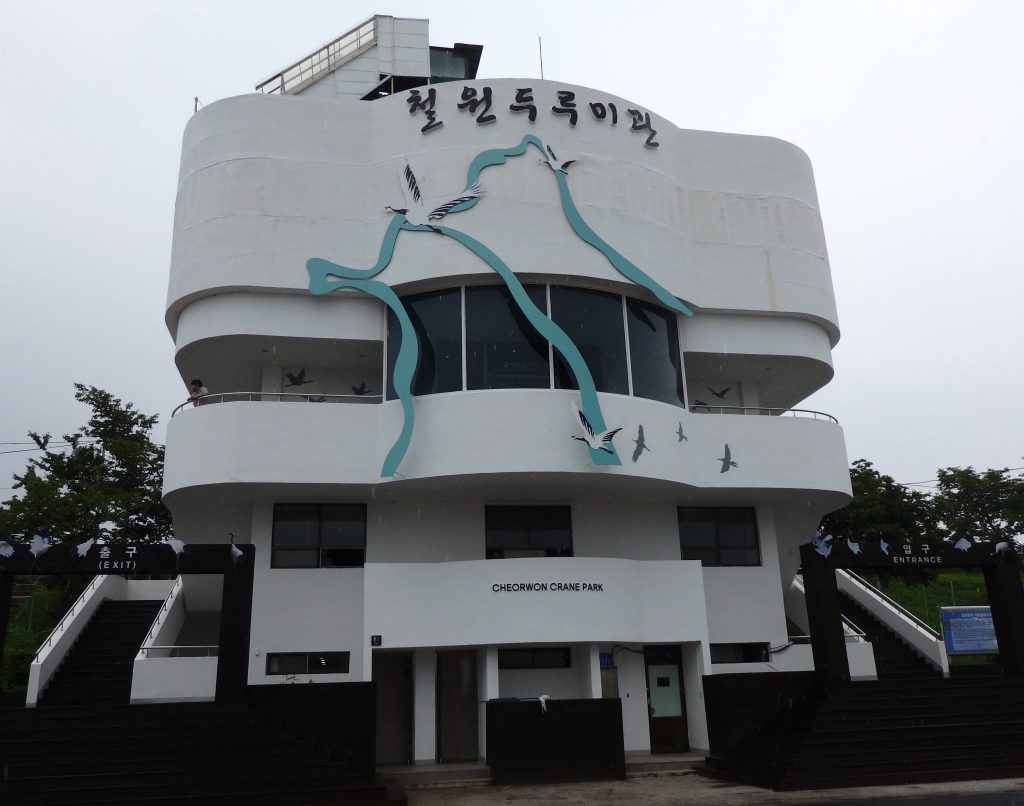
This just gave me the creeps – all those carefully posed dead animals – so I left quickly to take pictures outside while no one was paying attention to me.
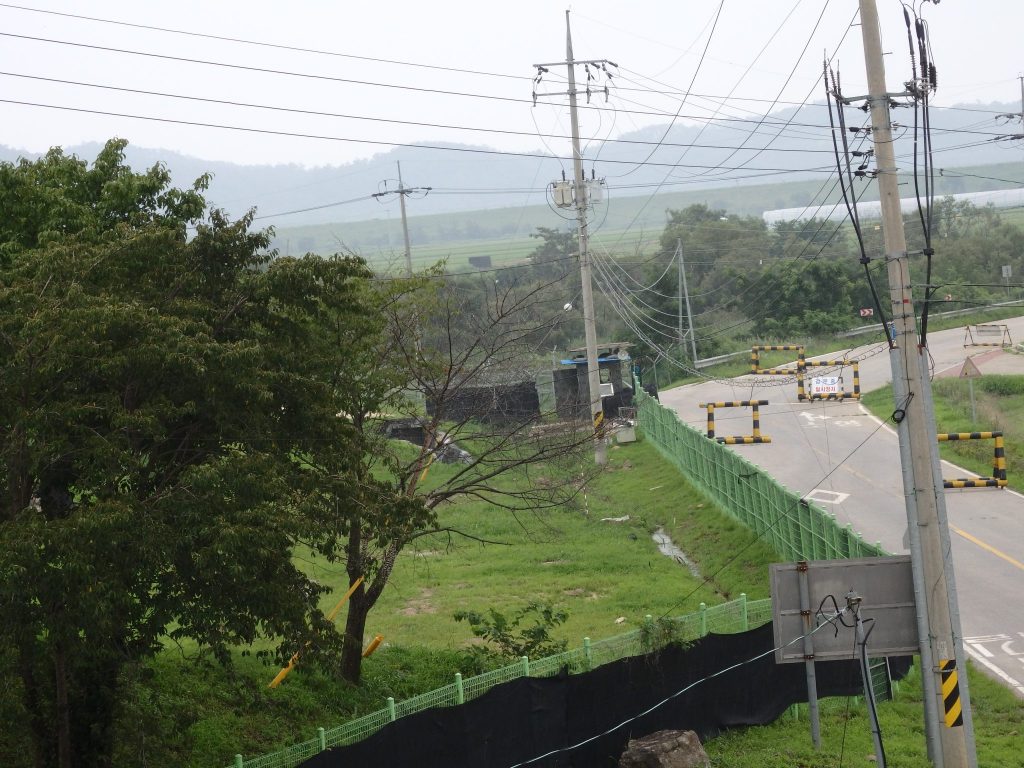
Baengma Battlefield Monument
The last stop was a tall monument, visible from a distance. An elegant sloping path cuts straight through a neatly-planted grove of white birches. Halfway up was a gallery listing many names and highlighting some of them with photographs. The displays were entirely in Korean, so at the time, we had no idea who was being memorialized. I learned after the trip that a major battle took place here in 1952 during the Korean War and thousands lost their lives. This monument honors them.
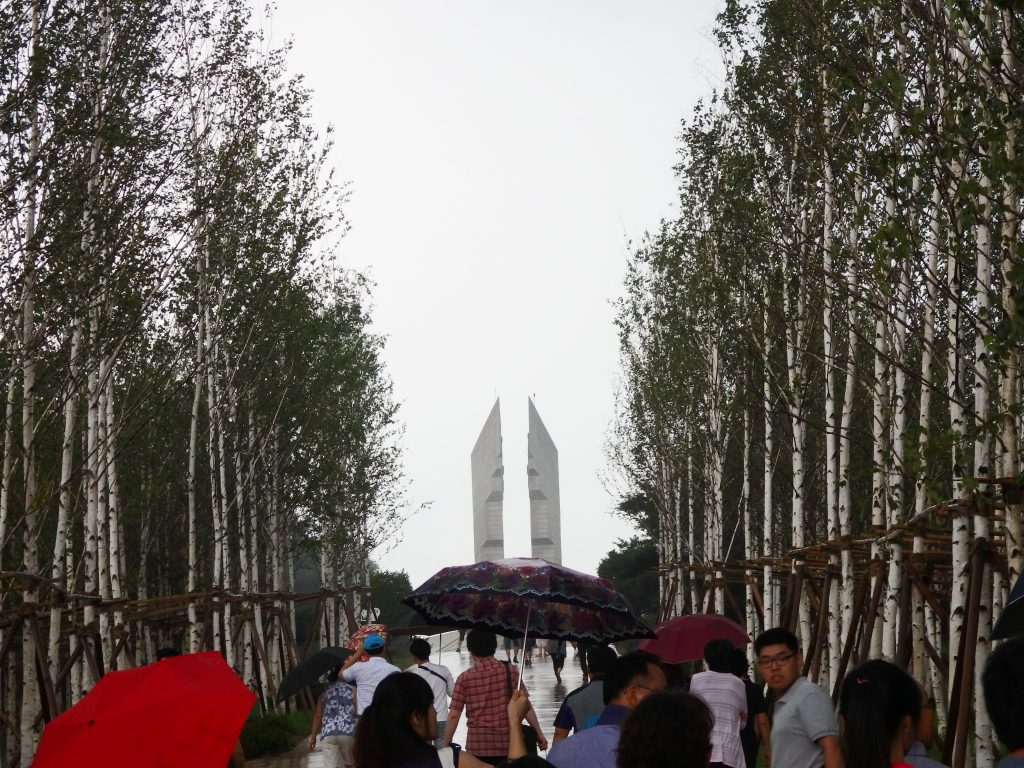
The high stone monument is in two parts, like shards that have broken apart. It seemed an apt representation of North and South Korea: so close, yet not united. Walking closer, I realized that, while the stone of the monument was smooth, the two flat faces, up high, facing each other, hold artwork. They seemed to be bas-relief carvings of horses, only really visible to each other.
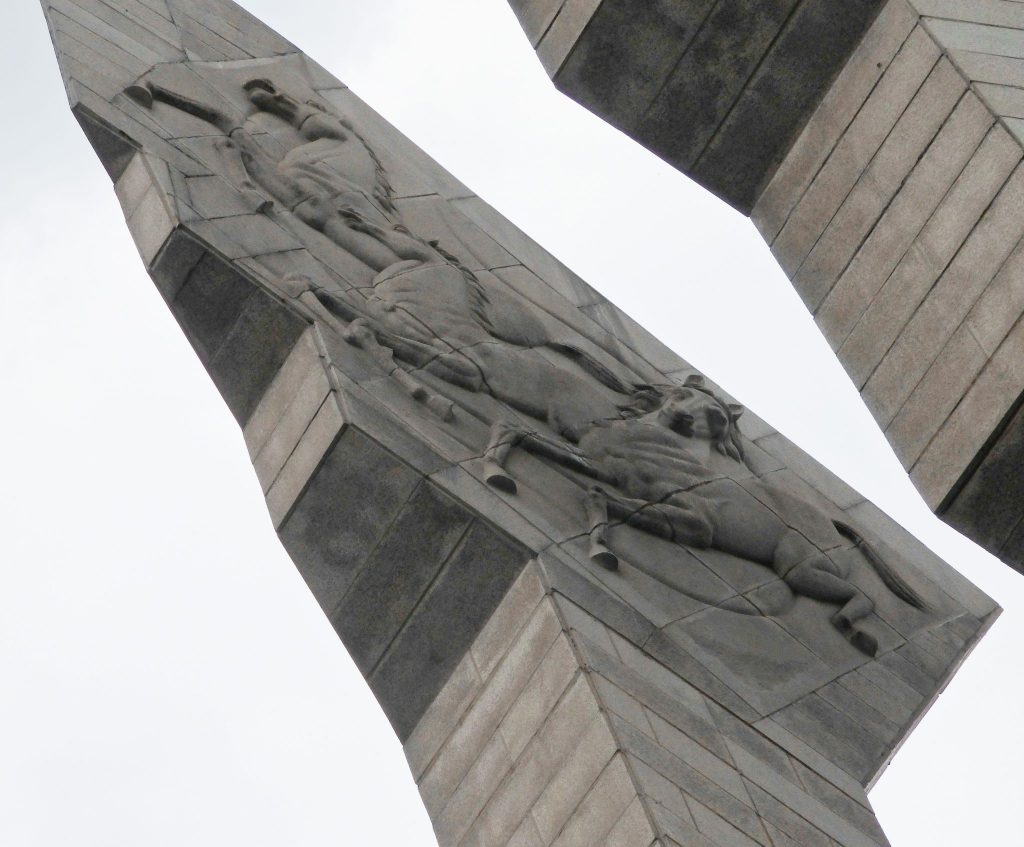
Despite the almost complete lack of English information, we were glad we took the trip, if only to sense the tension involved, not from North Korea, which we had no contact with, but from the rather touchy South Korean army.
The irony of talk of peace (the lunch was in a “Peace Center” and the train track is ostensibly intended to continue across the border some day) is how incredibly militarized the demilitarized zone is. Our distance from any element of the North Korean army just accentuated the paranoia of the South Korean Army. A case of doublespeak?
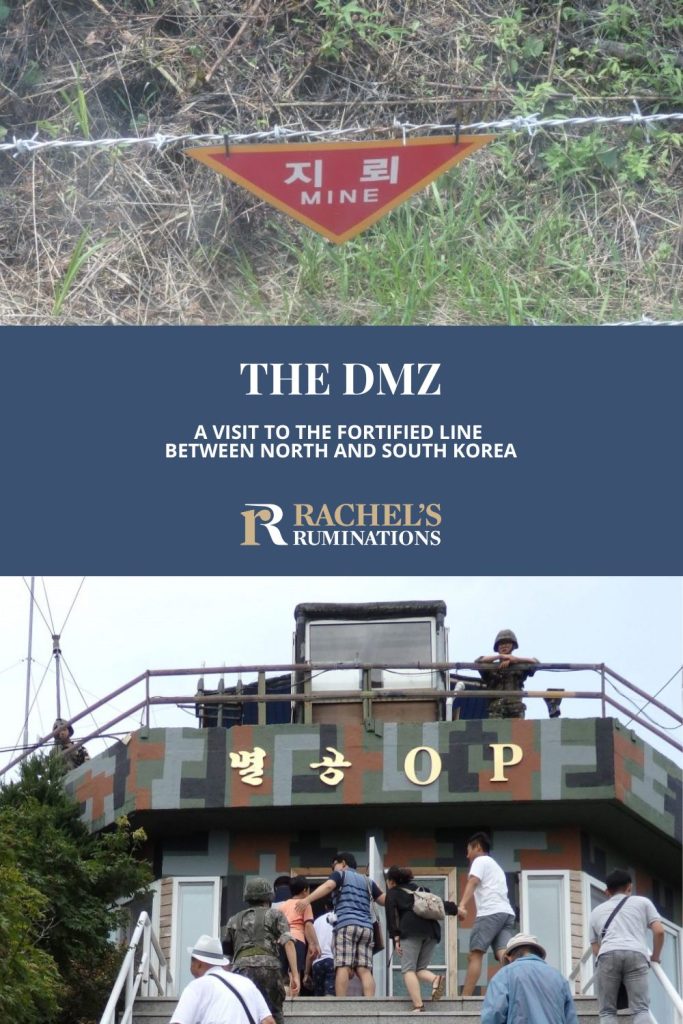
If you decide to visit the DMZ by train, look up your options on the Korail website beforehand. There are three different tour packages, all of which include a stop for lunch.
A bus tour may be a better choice, just because you’re sure to get full explanations from an English-speaking guide. Click on the images below for many options:
(Article updated September 18, 2024.)
My travel recommendations
Planning travel
- Skyscanner is where I always start my flight searches.
- Booking.com is the company I use most for finding accommodations. If you prefer, Expedia offers more or less the same.
- Discover Cars offers an easy way to compare prices from all of the major car-rental companies in one place.
- Use Viator or GetYourGuide to find walking tours, day tours, airport pickups, city cards, tickets and whatever else you need at your destination.
- Bookmundi is great when you’re looking for a longer tour of a few days to a few weeks, private or with a group, pretty much anywhere in the world. Lots of different tour companies list their tours here, so you can comparison shop.
- GetTransfer is the place to book your airport-to-hotel transfers (and vice-versa). It’s so reassuring to have this all set up and paid for ahead of time, rather than having to make decisions after a long, tiring flight!
- Buy a GoCity Pass when you’re planning to do a lot of sightseeing on a city trip. It can save you a lot on admissions to museums and other attractions in big cities like New York and Amsterdam.
Other travel-related items
- It’s really awkward to have to rely on WIFI when you travel overseas. I’ve tried several e-sim cards, and GigSky’s e-sim was the one that was easiest to activate and use. You buy it through their app and activate it when you need it. Use the code RACHEL10 to get a 10% discount!
- Another option I just recently tried for the first time is a portable wifi modem by WifiCandy. It supports up to 8 devices and you just carry it along in your pocket or bag! If you’re traveling with a family or group, it might end up cheaper to use than an e-sim. Use the code RACHELSRUMINATIONS for a 10% discount.
- I’m a fan of SCOTTeVEST’s jackets and vests because when I wear one, I don’t have to carry a handbag. I feel like all my stuff is safer when I travel because it’s in inside pockets close to my body.
- I use ExpressVPN on my phone and laptop when I travel. It keeps me safe from hackers when I use public or hotel wifi.



How interesting. I remember going through the DMZ in Vietnam and it was eerie.It is a paradox that the DMZ is so militarised considering the circumstances. Still, a very unique experience.
Indeed! It would be fun (in a grim sort of way) to visit both and write a post comparing the two.
I’ll have to admit that there’s much more to see in the DMZ than I expected. I mildly suggested this as a destination to my family and was met with MUCH resistance. Glad I could see it through your eyes. (And I do think that I’d perhaps mess up and somehow end up in jail for taking an unauthorized photo.)
I wasn’t originally planning to go either, till several people told me it was fascinating and I absolutely MUST go! It’s not like most tourist destinations, is it? We want to see beauty, culture, nature, etc. As for the unauthorized photos, at the moment I took them, I didn’t know it was unauthorized. In both cases I was told just after I took it.
I think it behooves Western citizens to see as much of these fortifications and separative attempts as possible, restrictive freedoms in their midst notwithstanding. Fascinating and unforgettable.
I agree! It’s something people SHOULD see. But I was disturbed by how it was packaged as fun and games.
What a fascinating journey to the DMZ that looks like it was definitely “authentic.” How nice that you and Nancie were able to meet each other!
Yes, it was great to get to know her. And we had a great time that day and one other day when we spent some time together.
‘Love the post and it would be interesting to see and if I did so, I would go on the more authentic tour.
I have also beeen to the DMZ in Vietnam. It’s quite sobering and eerie but a reminder of the outcome of war.
It is definitely sobering, which made it so strange how they tried to entertain us on the train!
How fascinating. I had no idea tours of the Demilitarized Zone between North and South Korea existed. You did such a fantastic job of describing what you experienced! And the photos are very descriptive in their own right.
Thanks so much for the kind words!
We so want to see the DMZ. Our daughter (The Piglet) went a few years ago and we were so jealous. Your story just makes us want to go even more.
Definitely worth a visit if you’re in Seoul!